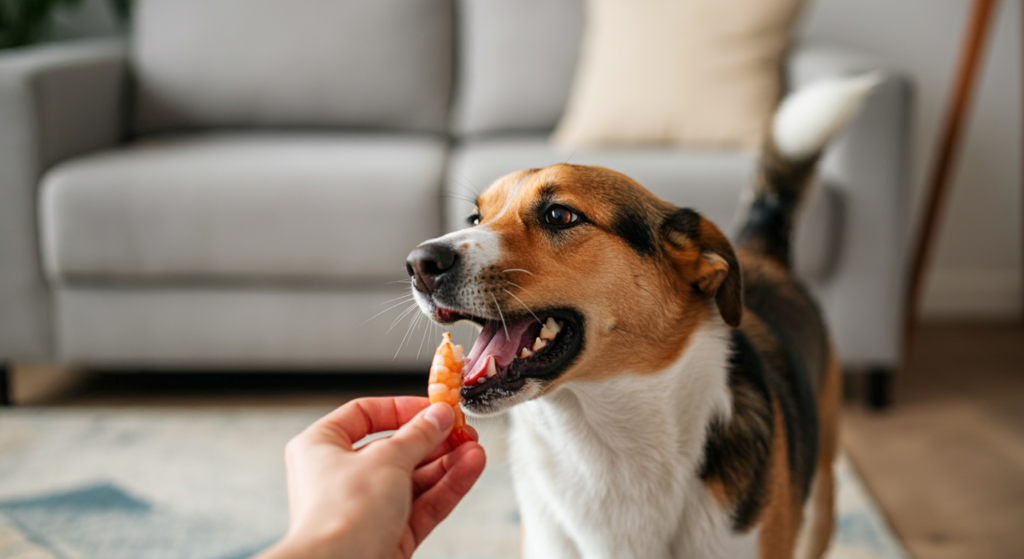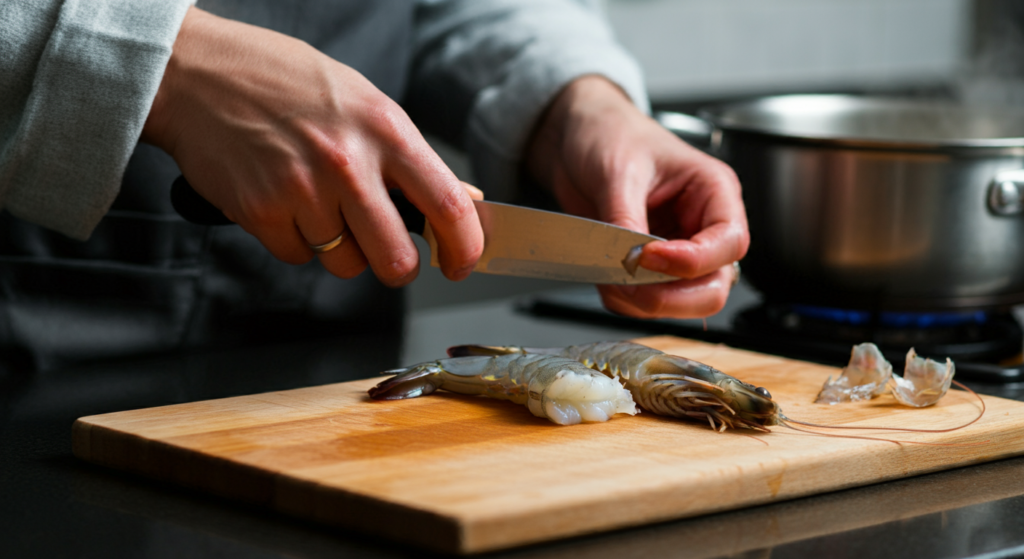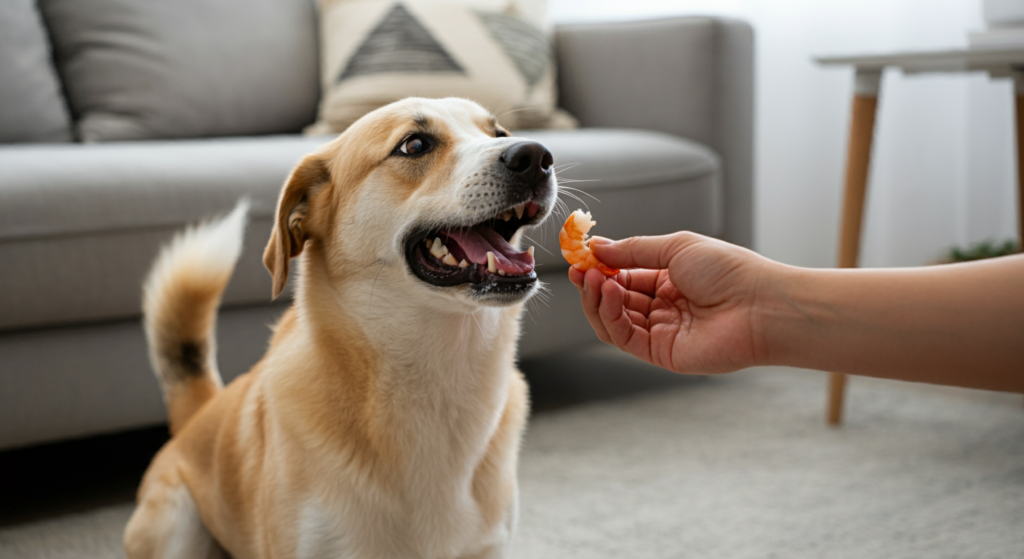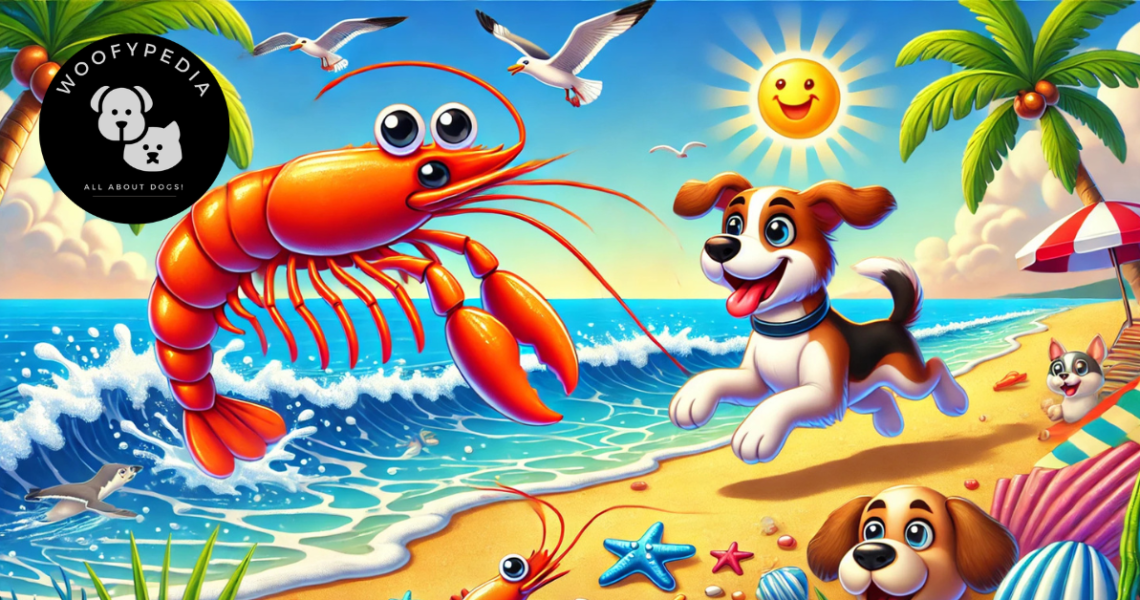Can Dogs Eat Prawns?
Introduction
As a dog owner, you might wonder if it’s safe to share prawns with your furry friend. Dogs often show interest in the foods we eat, but not all human foods are safe for them.
So, can dogs eat prawns? The short answer is yes, dogs can eat prawns, but with specific precautions. This article will explore the nutritional value of prawns, their safety for dogs, preparation tips, and other important considerations.
Are Prawns Safe for Dogs?
While prawns can be a healthy treat for dogs, it’s essential for pet owners to understand the associated risks and safety considerations before including them in their dog’s diet. Below, we expand on the factors to help ensure prawns are offered safely and responsibly.
Safe in Moderation
Prawns are not toxic to dogs and can be a nutritious occasional treat. However, they should not replace a dog’s balanced, regular diet. The key is moderation:
- Occasional Treat: Limit prawns to a treat rather than a staple food. Too much seafood can lead to dietary imbalances.
- Portion Control: Offer prawns in small amounts based on your dog’s size. For instance, one or two bite-sized pieces are sufficient for small dogs, while larger dogs can enjoy slightly more.
Risks of Feeding Prawns to Dogs
Although prawns are generally safe, they can pose certain risks if not prepared or offered correctly. Here are the dangers to watch out for:
- Allergies:
- Some dogs may be allergic to seafood, including prawns. Symptoms of an allergic reaction can include:
- Itching or excessive scratching.
- Swelling, particularly around the face, ears, or paws.
- Vomiting or diarrhoea.
- In severe cases, difficulty breathing.
- If you suspect an allergic reaction, stop feeding prawns immediately and consult your veterinarian.
- Choking Hazards:
- Prawns have hard shells, tails, and heads, which can pose significant choking risks or cause damage to the digestive tract if swallowed.
- Always ensure prawns are thoroughly cleaned and the shell, head, and tail are removed before offering them to your dog.
- Digestive Upset:
- Overfeeding prawns can overwhelm your dog’s stomach, leading to symptoms like diarrhoea, vomiting, or general discomfort.
- Dogs with sensitive stomachs may experience issues even with small amounts.
- High Sodium Content:
- Some prawns (especially pre-cooked or frozen varieties) may contain added salt. Excessive sodium can lead to dehydration or more severe health issues, such as salt poisoning.
Raw vs Cooked Prawns
- Raw Prawns:
- Feeding raw prawns is not recommended as they may carry harmful bacteria such as Salmonella or Vibrio, which can cause food poisoning in dogs.
- Raw prawns may also harbour parasites that could lead to infections if ingested.
- Cooked Prawns:
- Cooked prawns are safer and eliminate bacteria or parasites present in raw prawns.
- Cooking methods should be simple: boil or steam the prawns without adding any oils, butter, salt, or spices.
- Avoid common seasonings like garlic or onions, as these are highly toxic to dogs and can lead to severe health complications, including damage to red blood cells.

How to Safely Prepare Prawns for Dogs
To minimise risks and make prawns safe for dogs, follow these preparation guidelines:
- Clean Thoroughly:
- Remove the shell, head, and tail to prevent choking or digestive issues.
- Devein the prawns by removing the black line (the digestive tract) to avoid any potential contaminants.
- Cook Properly:
- Boil or steam the prawns until fully cooked.
- Ensure no seasonings, oils, or additives are used during preparation.
- Serve in Small Portions:
- Cut the prawns into bite-sized pieces appropriate for your dog’s size.
- Introduce prawns slowly, especially if it’s your dog’s first time eating them, and observe for any adverse reactions.
Prawns can be a nutritious and enjoyable treat for dogs when served in moderation and prepared correctly. They offer benefits like high-quality protein and essential nutrients but come with risks such as allergies, choking hazards, and potential digestive upset. Always serve prawns cooked, unseasoned, and in small portions to ensure your dog’s safety and well-being.
If you’re ever unsure about feeding prawns to your dog, consult your veterinarian for personalised advice.
How Much Prawn Can Dogs Eat?
The amount of prawn you can feed your dog depends on their size:
- Small dogs: 1-2 small pieces.
- Medium dogs: 2-3 pieces.
- Large dogs: 4-5 pieces.
Treat prawns as an occasional snack, not a regular meal.
When Not to Feed Prawns to Dogs
Avoid feeding prawns in the following situations:
- Allergies or sensitive stomachs: Dogs prone to allergies or digestive issues may not tolerate prawns well.
- Harmful preparation: Prawns cooked with garlic, butter, or spices are unsafe for dogs.
- Spoiled prawns: Never feed prawns that are past their prime.
Alternatives to Prawns
If prawns aren’t suitable for your dog, consider these other dog-friendly seafood options:
- Salmon: Cooked and deboned.
- Sardines: Unsalted and in water.
- Whitefish: Like cod or haddock.
For dogs allergic to seafood, vegetarian protein treats are a great alternative.
Prawn-Related Foods and Their Suitability for Dogs
- Prawn Crackers: Typically high in salt and fried; not recommended for dogs.
- Prawn Cocktail: Contains harmful ingredients like mayonnaise and spices; avoid feeding to dogs.
- Prawn Mayo Sandwich: Mayonnaise and bread aren’t ideal for dogs.
- Prawn Curry: Contains spices and ingredients toxic to dogs, such as onions and garlic.
- Prawn Cocktail Crisps: High in salt and artificial flavouring; unsuitable for dogs.
- Potted Shrimp: Often seasoned with butter and spices; unsafe for dogs.
- Prawn Spring Rolls: Contain harmful ingredients and are fried; not recommended.

Nutritional Value of Prawns
Prawns are packed with nutrients that can be beneficial for dogs. Below is a detailed nutritional breakdown per 100 grams of cooked prawns and how they contribute to a dog’s health, alongside their approximate Recommended Daily Allowance (RDA) for an average-sized dog (15kg):
| Nutrient | Amount per 100g | Benefits | RDA Contribution |
|---|---|---|---|
| Protein | 24g | Essential for muscle development and repair. | Meets ~50% of daily protein needs. |
| Vitamin B12 | 11.5 mcg | Supports nervous system health and energy metabolism. | Exceeds daily requirement (2.4 mcg). |
| Selenium | 40 mcg | Acts as an antioxidant and supports immune function. | 80% of daily requirement (50 mcg). |
| Phosphorus | 200 mg | Builds strong bones and teeth. | 20% of daily requirement (1,000 mg). |
| Omega-3 Fatty Acids | 540 mg | Promotes a healthy coat, skin, and joints. | Contributes significantly to daily needs. |
| Calories | 99 kcal | A low-calorie option for dogs needing to maintain a healthy weight. | Minimal caloric impact. |
| Fat | 0.3g | A low-fat treat suitable for dogs prone to weight gain. | Negligible impact on fat intake. |
These benefits make prawns a nutritious snack for dogs, but moderation is key. While the nutrients in prawns can contribute positively to a dog’s diet, overfeeding or improper preparation can negate these advantages. Always serve prawns cooked, deveined, and without seasoning.

FAQs
1. Can puppies eat prawns?
Puppies can eat prawns in moderation, but it’s crucial to introduce them slowly to avoid potential digestive upset or allergic reactions. Start with a small piece of cooked, deveined, and unsalted prawn. Monitor for signs of an allergy or intolerance, such as itching, swelling, or diarrhoea. Puppies have more sensitive stomachs than adult dogs, so always consult your vet before introducing new foods.
2. Can dogs eat king prawns?
Yes, dogs can eat king prawns if they are properly prepared. Always cook the prawns thoroughly, remove the shell, head, tail, and devein them to eliminate harmful bacteria or potential choking hazards. Serve in small, unseasoned portions to ensure they are safe and easy for your dog to digest.
3. Can I give my dog cooked prawns?
Yes, cooked prawns are safe for dogs as long as they are plain and unseasoned. Boil or steam the prawns without adding oils, butter, salt, or spices. Proper preparation reduces the risk of digestive upset and ensures the prawns are a healthy treat.
4. What seafood should dogs not eat?
Dogs should avoid certain types of seafood, including:
- Raw fish or shellfish: These may contain harmful bacteria or parasites.
- Shellfish with shells: Hard shells can cause choking or digestive blockages.
- Seafood with toxic additives: Avoid seafood prepared with garlic, onions, butter, or excessive salt, as these ingredients can harm dogs.
5. Can I feed my dog prawn shells?
No, you should not feed your dog prawn shells. The shells are hard to chew and can pose a choking hazard. They may also cause blockages or irritation in the digestive tract if ingested.
6. How do I know if my dog is allergic to prawns?
To determine if your dog is allergic to prawns, watch for these signs after feeding:
- Itching or excessive scratching.
- Redness or swelling around the face or paws.
- Vomiting or diarrhoea.
- Difficulty breathing (in severe cases).
If any of these symptoms occur, stop feeding prawns and contact your veterinarian immediately.
7. Can prawns make dogs sick?
Yes, prawns can make dogs sick if they are:
- Raw or undercooked: These may carry harmful bacteria like Salmonella or Vibrio.
- Overfed: Too many prawns can upset a dog’s stomach and cause diarrhoea.
- Seasoned or spoiled: Ingredients like garlic, butter, or spoiled prawns can cause serious health issues.
8. Can I give my dog prawn cocktail crisps?
No, prawn cocktail crisps are not suitable for dogs. They are high in salt, artificial flavours, and other additives that can harm your dog’s health. Stick to natural, dog-friendly treats instead.
9. How should I cook prawns for dogs?
Cook prawns for dogs by boiling or steaming them without adding any seasoning, oils, or butter. After cooking, remove the shell, head, and tail, devein the prawn, and let it cool. Serve in small, bite-sized pieces to make it easy for your dog to eat safely.
10. What happens if my dog eats a prawn shell?
If your dog eats a prawn shell, monitor them for signs of choking, discomfort, or digestive issues like vomiting or constipation. While some dogs may pass the shell without issues, others may experience blockages or irritation. Contact your vet if you notice any concerning symptoms.
11. Can we eat prawns after a dog bite?
Yes, prawns are safe to eat after a dog bite as long as they have been properly stored and cooked. The bite itself does not affect the prawns’ safety for human consumption.
12. How often can dogs eat prawns?
Dogs can eat prawns occasionally as a treat, not as a regular part of their diet. Limit the frequency to once or twice a week and ensure the portion size is appropriate for your dog’s size to prevent overfeeding or nutritional imbalances.
Conclusion
Dogs can eat prawns safely when properly prepared and given in moderation. Always remove shells and tails, cook thoroughly, and avoid harmful seasonings. While prawns can be a nutritious treat, it’s crucial to monitor your dog for any adverse reactions. For more information on safe human foods for dogs, consult your vet or explore related articles.
